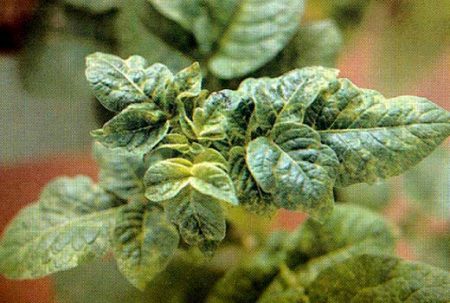
A wrinkled mosaic is a slow death for potatoes. This is an inherited disease, the primary symptoms of which pass almost imperceptibly. This is all danger. Moreover, wrinkled leaves of the leaves are not able to cure any drugs, so the infected course is doomed to death.
To grow a good potato crop, gardeners make a lot of effort. In addition to caring for plants, you also need protection. But not always fertilizers and insecticides can save tubers. If curly leaves began to appear on the tops, these are signs of infection of the wrinkled mosaic. There is no cure for this virus. Only prevention will help preserve the crop, and to stop the spread of the virus is the complete destruction of the vegetation.
There are several types of potato mosaics, in this article we will consider one of the most dangerous viruses - wrinkled mosaics.
Content
Wrinkled mosaic: description of infection
The defeat of the virus is expressed in severe bloating of the plant leaf. This causes the leaves to curl down. Not every experienced gardener will be able to "calculate" the virus on his potato, because in the first year it is weakly expressed. But already in the second and subsequent offspring of tubers, infection can be determined.
Infected potatoes are significantly slower in growth than a healthy plant. The tops are becoming curly. This is especially noticeable in comparison with healthy leaves. It also happens that from the mosaic stems fall to the ground. Soon, such a bush dies.
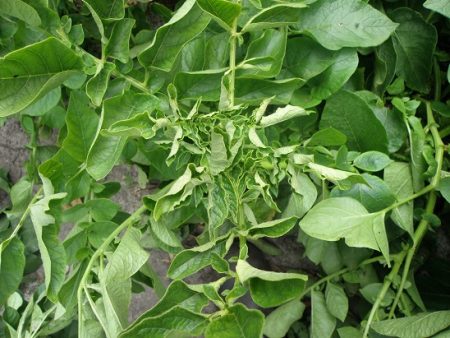
Often, due to the prevailing conditions of plant growth and development, the causative agents of viral diseases can be in a hidden form, which complicates their diagnosis by external symptoms. In such cases, one has to resort to other methods of determination and, first of all, to serological diagnostics.
Causes and causative agents of wrinkled mosaic
The causative agents of wrinkled mosaics are several viruses:
- Potato Y virus (Potato virus Y, PVY);
- combination of viruses X and Y (PVX + PVY).
Most often, the virus spreads in southern Russia, but other regions of the country are no exception. The first signs of the disease are difficult to determine - first, small, barely noticeable tubercles form between leaf veins. Then the edge of the leaf begins to bend. Plant cells infected with a wrinkled mosaic can no longer retain moisture. Therefore, on especially sunny days, the bush dies.
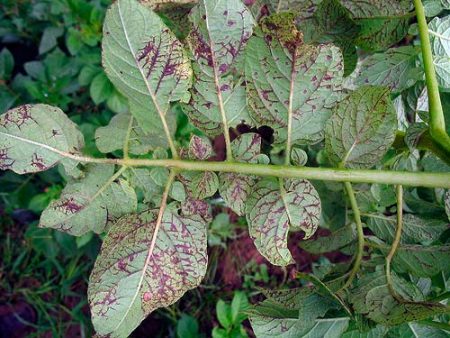
If seed potatoes are infected with mosaics, then they will give the tops scanty and lethargic. Such plants die off quickly. Not having time to saturate with useful minerals tubers, all the greens fall. In such cases, crop loss is up to 80 percent.
The virus is transmitted through insect pests and rodents, as well as in other ways. But most often the mosaic moves from one plant to another through the juice of an infected tuber or leaf. Take this into account when digging potatoes. If the tuber is damaged, then it is first exposed to infection.
Wrinkled Mosaic
Unfortunately, treating a wrinkled mosaic is useless. The only thing that can save the crop from the virus is some preventive action. As a rule, these are elementary things: healthy seeds and timely spraying of beds with insecticides.
Pests can also be mosaic carriers, so it is extremely important to protect your crop from insects and rodents.
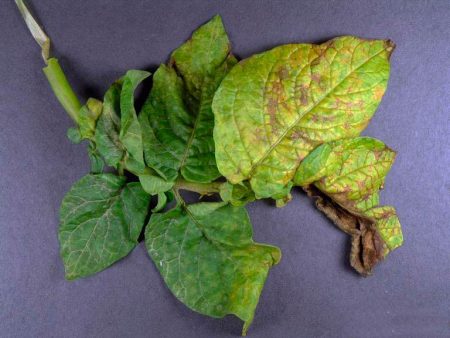
It often happens that the causative agents of the virus are hidden from the naked eye. By any signs, it is quite difficult to detect the mosaic. In such situations, quarantine inspection services will come to the rescue.
All infected plants should be dug up and burned as far from the beds as possible so as not to infect healthy plants. Even those bushes that are not completely infected are also worth destroying. Mosaic does not spare any culture, and the longer the viral course is on the bed, the further the infection spreads.
Potato Mosaic Prevention
Since there is no means to combat potato disease in order to avoid mosaic infection, the farmer must take preventative measures:
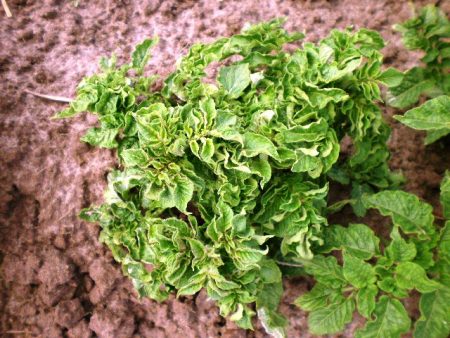
- If faint spots began to appear on the leaves, then the plant should be taken to the laboratory to determine the degree of infection and the cause.
- All viruses dangerous for potatoes die at temperatures above 60 degrees Celsius. Therefore, boiled tubers of the affected culture can be given to animals for eating, people can not eat them. Damaged tops must be burned to kill the virus.
- In order to avoid a possible mosaic disease on other plants, it is not recommended to plant tomatoes, peppers and eggplant near potatoes. Since all species of nightshade are also susceptible to this dangerous virus.
- All weeds must be carefully scooped up together with the roots, as they are also susceptible to infection by mosaics and are able to “transmit” the virus to potatoes and other crops.
- Seed potatoes are always stored separately from those intended for human consumption. This prevents the seeds from possible infection.
- On large farms, infected potatoes are checked under ultraviolet light. When emitted, diseased tubers turn blue or even blue.
- Before planting tubers in the ground, potatoes are treated with insecticides. This will not only prevent possible virus infection, but also protect against pests.
- If on a site that has already been infected with mosaics, to grow potatoes again, it is not recommended to pick flowers at the tops. Otherwise, the virus may fall into the slice, and then the death of the plant is inevitable.
Each gardener and gardener is laid out at 100 percent on his plot. A good harvest requires attention and is forgotten, and the fruits, for many, are the only way to survive the cold winter. Therefore, the loss of it is for many comparable to disaster. It is extremely important to take care of plant protection in advance so that you do not suffer losses in the fall.




 Description and description of varieties in Belarus with a photo
Description and description of varieties in Belarus with a photo Do I need to pick flowers from potatoes: why do they do it
Do I need to pick flowers from potatoes: why do they do it When to dig potatoes: timing and availability of new potatoes
When to dig potatoes: timing and availability of new potatoes How to grow a good potato crop: various methods and methods, planting and care
How to grow a good potato crop: various methods and methods, planting and care